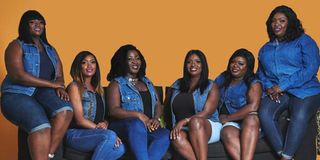Of the gender gap and why some spaces need to stay single-sex

Malkeeya Band, who alongside all-male compatriots, Vipaji, represented Kenya in Season 2 of of Old Mutual Amazing Voices singing competition.
What you need to know:
- An Australian court overturned a ban on Ladies Lounge, a women-only art gallery in Tasmania, ruling that it promotes equal opportunity.
- The gallery deliberately mimics historical Australian pubs that excluded women until 1965, but reverses roles by having male butlers serve female guests while denying entry to male visitors.
- The case highlights how gender-segregated spaces can serve legitimate purposes in addressing historical wrongs and unique needs.
In late September, an Australian court lifted a ban on a women's only art gallery located in the southern state of Tasmania and declared that it did not amount to discrimination against men. It overturned the ruling of a lower court, which had banned the Ladies Lounge at the Museum of Old and New Art (Mona), in response to a successful suit filed earlier by Jason Lau, a male visitor to the museum. The appellate judge, Justice Shane Marshall, maintained that the law allowed discrimination if it promoted “equal opportunity” for a marginalised group. In this case, it gave “women a rare glimpse of what it is like to be advantaged rather than disadvantaged”.
According to the Tasmanian Anti-Discrimination Act (1998), one is not allowed to treat someone differently based on an attribute or characteristic like gender, sexual orientation, race, religion or disability. However, the law also provides that “a person may discriminate against another in any program, plan or arrangement designed to promote equal opportunity for a group of people who are disadvantaged or have a special need because of a prescribed attribute”.
Critics of the original court decision in Australia observed that there were many gender-disaggregated gymnasia and even men’s only clubs, which have never been condemned as discriminatory. The background to this is that “the velvet-clad lounge” established in 2020, was deliberately designed to mimic “an old Australian pub – a space that largely excluded women until 1965 – and turn it on its head, offering champagne and five-star service to female attendees, while refusing men at the door”. The only men allowed were butlers “to serve women, attending to their every wish and showering them with praise and affection”.
In its response to the lawsuit, the lounge creator, Kirsha Kaechele, argued that rejection of Lau “was part of the artwork”. In other words, his feeling of being discriminated against was exactly what women have felt for centuries. The case thus illustrates the adage that it is the wearer of the shoe who knows where it pinches. The lounge put the shoe in the foot of the non-wearer who, in this case, did not like the pinch. If it is not good for the goose, why should it be good for the gander?
The case raises a number of questions. One, what does it take for the privileged to understand discrimination? Two, is it discriminatory to have gender-segregated services and spaces? Three, what is discrimination?
Discrimination is any overt or covert act of exclusion that impairs one’s access to and enjoyment of resources, services, opportunities and benefits in the social, economic, political or other spheres based on one’s attribute. However, such acts are not considered discriminatory if designed to correct historical wrongs or if inherently required in a particular context. This is the principle of affirmative action, also referred to as positive discrimination. Kenya has many women-only services and facilities primarily to redress historical imbalances and address gender needs unique to one group.
The Women’s Enterprise Fund and the Kenya Women Micro-Finance Bank exclusively target women for business capital. There is also the county woman representative seat in the National Assembly. We also have girls-only and boys-only primary and secondary schools, as well as Kiriri Women’s University of Science and Technology.
In many Islamic countries, social facilities and services are routinely segregated by sex, based on sectarian and practical principles. There are even countries with public transport vehicles exclusively for women in response to their gender roles and security concerns.
The annual ‘Man Cave’ is deliberately designed as an exclusive forum for men to delve into masculinity issues. It would be quite absurd to run to court and claim that this is discrimination against women. To make it more dramatic, can a man demand use of the women’s lavatory arguing that denying him the opportunity is discrimination or demand to be allowed into a women-only gym? In simple terms, affirmative action and raw discrimination are distinguished by context and purpose.
Read: Barbados: What Kenya can pick from the all-female leadership
Back to feeling the pinch, a simple experiment worth trying to make men and women realise what it means to be the other is to reverse roles. For a start, suppose men took up domestic work in a family with a baby. Most would not withstand the demands of the baby, and the tedium of feeding and changing diapers, keeping the babies away from harm and deciphering their communication. Many will not even know how to prepare and serve the child’s food.
The writer is a lecturer in Gender and Development Studies at South Eastern Kenya University ([email protected]).





